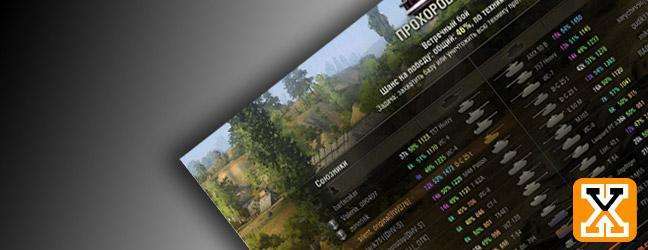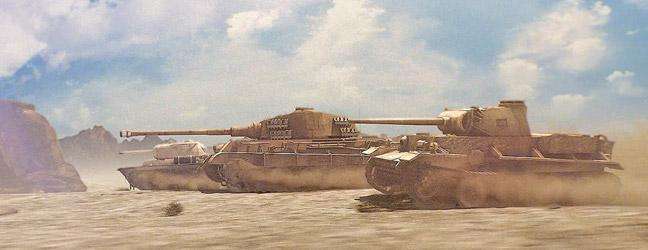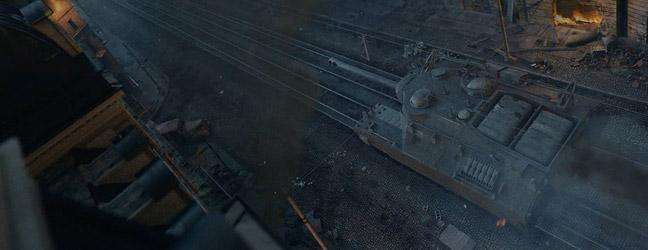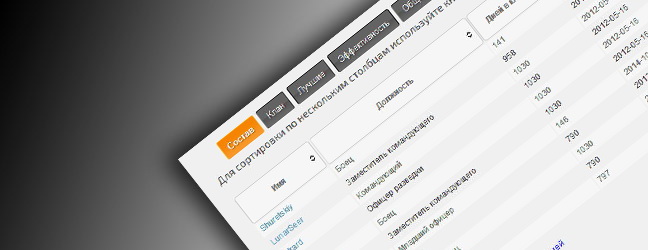Stalin the Third
Дата: 13.05.2011 19:25:17
admin: 
IS-3 (Object 703) is the Soviet heavy tank of WWII. This steel monster was put into mass production in the final period of war but combat actions were over before it was supplied to the troops. That’s why this vehicle is often being classified as one of the first tanks of post war period. This tank was the continuator of the IS-tanks genus and got the numeral designation “3”. Due to the interesting frontal armor plating arrangement “pike-nose” it got the nickname “Pike”.
The creation of the new heavy tank project codenamed “Kirovets-1” began in the late summer of 1944 and had its own prehistory. The group of research officers headed by Engineer-Colonel A. Zavialov studied the character of damages caused by shell hits on the tank fields of Kursk Battle operation. Attention was drawn to the mass destruction of tanks caused by hits in the frontal part of the hull and turret. The project of new heavy tank IS-3 was developed according to the obtained data.
The main requirement to this new tank was the increase of protection characteristics. It was also planned to change the cast construction of the frontal part to the welded one. This solution was supposed to reduce penetrability of the tank armor by the cannons of Tiger and Panther tanks using armor-piercing and sub-caliber projectiles from all distances. It was also planned to rework the construction of the turret as it was the most vulnerable part of IS-2.
The experience of IS tanks military service had shown that the design of chassis, tank power package and transmission didn’t require any modifications to be mounted on IS-3. The hull of the tank was welded from rolled armor and had no parts of cast armor. The design of the dual inclined nose resolved the issue of the driver-mechanic hatch placement (previous type of IS-tanks had no driver hatch at all). The visibility for the driver mechanic was also significally improved as well as the frontal hull armor plating. Fuel tanks were moved from the combat to the engine compartment to reduce the danger of fire. Tank armament remained the same: 122-mm cannon D-25 and coaxial 7.62-mm DT machine gun, on the roof of the turret was mounted 12.7-mm anti-aircraft DShK machine gun. Bow machine gun and rear machine gun were not mounted.
The IS-3 turret traversing mechanism was arranged in a very interesting way: the electric drive was equipped with a commander's control system. While keeping the target in sight of his vision devices, the commander could push a special button and turn the tower in a direction needed along the shortest path. When the sight line coincided with gun bore line, the tower stopped.
December 18-24, 1944, IS-3 was officially tested in the training range. The tests included run-on operations and attacking by Wespe SPG's and ISU-122's armor-piercing guns from the distance of 600-800 m. The tank did well on the way, and the shelling showed that the front upper armor plate of the hull was not penetrated by a 88-mm armor-piercing shell at 350 m (it left a dent 28-mm deep), and was not penetrated by a 122-mm armor-piercing shell at the distance of 690 m (a dent 35-mm deep). But the front of the turret was penetrated by a 88-mm armor-piercing shell at 300 m, and the side and rare of the tank - at 1000 m.
After the military tests the Object 703 was demonstrated to G. Zhukov and A. Vasilevsky. The Marshals reported on the new machine to Joseph Stalin, who passed the tank into service of Red Army, and its production was started at the Kirov Factory in Chelyabinsk.
Despite numerous rumors and speculation, IS-3 showed up late to the war. When the armed forces of Nazi Germany were signing the act of capitulation, the tanks were still at the factory. Thus, they did not take part in battle action. Moreover, they did not commit in the Far East battles, which took place in August-September, 1945. Nevertheless, September 7, 1945, the tank regiment, armed with those fighting vehicles, took part in the Red Army Parade, which was held in Berlin in commemoration of the victory over Japan, and those vehicles made a strong impression on the USSR Allies of the Anti-Hitler coalition.

IS-3 (Object 703) is the Soviet heavy tank of WWII. This steel monster was put into mass production in the final period of war but combat actions were over before it was supplied to the troops. That’s why this vehicle is often being classified as one of the first tanks of post war period. This tank was the continuator of the IS-tanks genus and got the numeral designation “3”. Due to the interesting frontal armor plating arrangement “pike-nose” it got the nickname “Pike”.
The creation of the new heavy tank project codenamed “Kirovets-1” began in the late summer of 1944 and had its own prehistory. The group of research officers headed by Engineer-Colonel A. Zavialov studied the character of damages caused by shell hits on the tank fields of Kursk Battle operation. Attention was drawn to the mass destruction of tanks caused by hits in the frontal part of the hull and turret. The project of new heavy tank IS-3 was developed according to the obtained data.
The main requirement to this new tank was the increase of protection characteristics. It was also planned to change the cast construction of the frontal part to the welded one. This solution was supposed to reduce penetrability of the tank armor by the cannons of Tiger and Panther tanks using armor-piercing and sub-caliber projectiles from all distances. It was also planned to rework the construction of the turret as it was the most vulnerable part of IS-2.
The experience of IS tanks military service had shown that the design of chassis, tank power package and transmission didn’t require any modifications to be mounted on IS-3. The hull of the tank was welded from rolled armor and had no parts of cast armor. The design of the dual inclined nose resolved the issue of the driver-mechanic hatch placement (previous type of IS-tanks had no driver hatch at all). The visibility for the driver mechanic was also significally improved as well as the frontal hull armor plating. Fuel tanks were moved from the combat to the engine compartment to reduce the danger of fire. Tank armament remained the same: 122-mm cannon D-25 and coaxial 7.62-mm DT machine gun, on the roof of the turret was mounted 12.7-mm anti-aircraft DShK machine gun. Bow machine gun and rear machine gun were not mounted.
The IS-3 turret traversing mechanism was arranged in a very interesting way: the electric drive was equipped with a commander's control system. While keeping the target in sight of his vision devices, the commander could push a special button and turn the tower in a direction needed along the shortest path. When the sight line coincided with gun bore line, the tower stopped.
December 18-24, 1944, IS-3 was officially tested in the training range. The tests included run-on operations and attacking by Wespe SPG's and ISU-122's armor-piercing guns from the distance of 600-800 m. The tank did well on the way, and the shelling showed that the front upper armor plate of the hull was not penetrated by a 88-mm armor-piercing shell at 350 m (it left a dent 28-mm deep), and was not penetrated by a 122-mm armor-piercing shell at the distance of 690 m (a dent 35-mm deep). But the front of the turret was penetrated by a 88-mm armor-piercing shell at 300 m, and the side and rare of the tank - at 1000 m.
After the military tests the Object 703 was demonstrated to G. Zhukov and A. Vasilevsky. The Marshals reported on the new machine to Joseph Stalin, who passed the tank into service of Red Army, and its production was started at the Kirov Factory in Chelyabinsk.
Despite numerous rumors and speculation, IS-3 showed up late to the war. When the armed forces of Nazi Germany were signing the act of capitulation, the tanks were still at the factory. Thus, they did not take part in battle action. Moreover, they did not commit in the Far East battles, which took place in August-September, 1945. Nevertheless, September 7, 1945, the tank regiment, armed with those fighting vehicles, took part in the Red Army Parade, which was held in Berlin in commemoration of the victory over Japan, and those vehicles made a strong impression on the USSR Allies of the Anti-Hitler coalition.
 News from the Front\Developers Blog\Stalin the Third
News from the Front\Developers Blog\Stalin the Third













